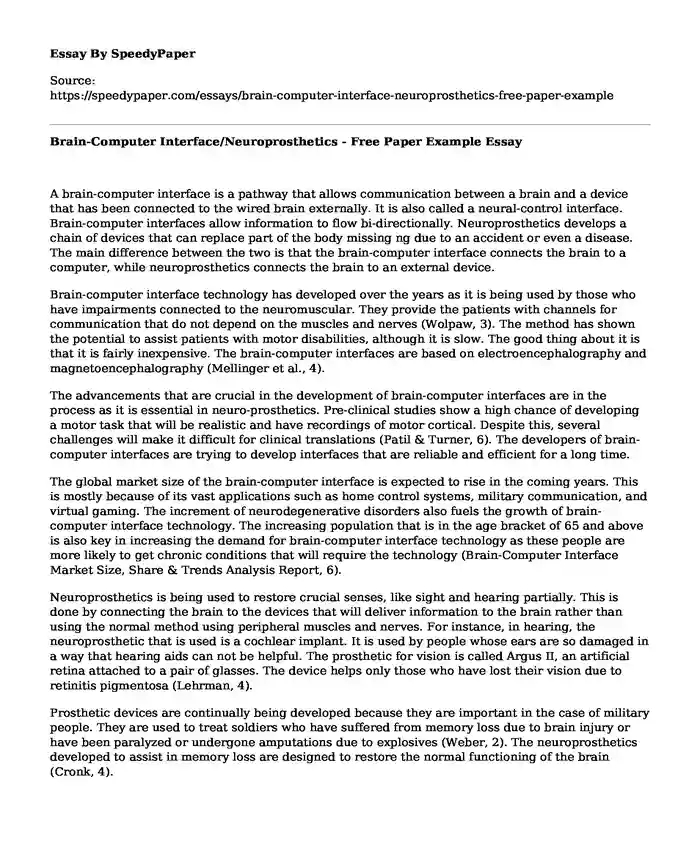
| Type of paper: | Essay |
| Categories: | Computer science Technology Development |
| Pages: | 3 |
| Wordcount: | 766 words |
A brain-computer interface is a pathway that allows communication between a brain and a device that has been connected to the wired brain externally. It is also called a neural-control interface. Brain-computer interfaces allow information to flow bi-directionally. Neuroprosthetics develops a chain of devices that can replace part of the body missing ng due to an accident or even a disease. The main difference between the two is that the brain-computer interface connects the brain to a computer, while neuroprosthetics connects the brain to an external device.
Brain-computer interface technology has developed over the years as it is being used by those who have impairments connected to the neuromuscular. They provide the patients with channels for communication that do not depend on the muscles and nerves (Wolpaw, 3). The method has shown the potential to assist patients with motor disabilities, although it is slow. The good thing about it is that it is fairly inexpensive. The brain-computer interfaces are based on electroencephalography and magnetoencephalography (Mellinger et al., 4).
The advancements that are crucial in the development of brain-computer interfaces are in the process as it is essential in neuro-prosthetics. Pre-clinical studies show a high chance of developing a motor task that will be realistic and have recordings of motor cortical. Despite this, several challenges will make it difficult for clinical translations (Patil & Turner, 6). The developers of brain-computer interfaces are trying to develop interfaces that are reliable and efficient for a long time.
The global market size of the brain-computer interface is expected to rise in the coming years. This is mostly because of its vast applications such as home control systems, military communication, and virtual gaming. The increment of neurodegenerative disorders also fuels the growth of brain-computer interface technology. The increasing population that is in the age bracket of 65 and above is also key in increasing the demand for brain-computer interface technology as these people are more likely to get chronic conditions that will require the technology (Brain-Computer Interface Market Size, Share & Trends Analysis Report, 6).
Neuroprosthetics is being used to restore crucial senses, like sight and hearing partially. This is done by connecting the brain to the devices that will deliver information to the brain rather than using the normal method using peripheral muscles and nerves. For instance, in hearing, the neuroprosthetic that is used is a cochlear implant. It is used by people whose ears are so damaged in a way that hearing aids can not be helpful. The prosthetic for vision is called Argus II, an artificial retina attached to a pair of glasses. The device helps only those who have lost their vision due to retinitis pigmentosa (Lehrman, 4).
Prosthetic devices are continually being developed because they are important in the case of military people. They are used to treat soldiers who have suffered from memory loss due to brain injury or have been paralyzed or undergone amputations due to explosives (Weber, 2). The neuroprosthetics developed to assist in memory loss are designed to restore the normal functioning of the brain (Cronk, 4).
Conclusion
In summation, brain-computer interfaces and neuroprosthetics are beneficial, so the government supports the development of the technology. The technology is expected to rise as it has many uses with the most important function of it being the treatment of patients with motor disorders. This gives hope to people thereby improving patient experience and quality of care.
Works Cited
Cronk, Terri Moon. “DARPA Developing Implants to Help With TBI Memory Loss.” U.S. DEPARTMENT OF DEFENSE, DOD News, 15 July 2014, www.defense.gov/Explore/News/Article/Article/602880/darpa-developing-implants-to-help-with-tbi-memory-loss/.
Weber, Douglas. “Neuroprosthetics and Solutions for Restoring Sensorimotor Functions.” Medical Design Briefs, 23 Aug. 2019, www.medicaldesignbriefs.com/component/content/article/mdb/tech-briefs/7873.
Lehrman, Emily. “Bionic Senses: How Neuroprosthetics Restore Hearing and Sight.” Science in the News, 16 Mar. 2013, sitn.hms.harvard.edu/flash/2013/issue138a/.
“Brain-Computer Interface Market Size: Industry Report, 2027.” Brain-Computer Interface Market Size | Industry Report, 2027, Feb. 2020, www.grandviewresearch.com/industry-analysis/brain-computer-interfaces-market.
Mellinger, Jürgen, et al. “An MEG-Based Brain-Computer Interface (BCI).” NeuroImage, Academic Press, 27 Mar. 2007, www.sciencedirect.com/science/article/abs/pii/S1053811907002261?via=ihub.
Patil, Parag G, and Dennis A Turner. “The Development of Brain-Machine Interface Neuroprosthetic Devices.” Neurotherapeutics: the Journal of the American Society for Experimental NeuroTherapeutics, Springer-Verlag, Jan. 2008, www.ncbi.nlm.nih.gov/pmc/articles/PMC5084136/?tool=pmcentrez.
Wolpaw, Jonathan, et al. “Brain-Computer Interface Technology: A Review of the First International Meeting.” Brain-Computer Interface Technology: a Review of the First International Meeting - IEEE Journals & Magazine, 2020, ieeexplore.ieee.org/document/847807.
Cite this page
Brain-Computer Interface/Neuroprosthetics - Free Paper Example. (2024, Jan 07). Retrieved from https://speedypaper.net/essays/brain-computer-interface-neuroprosthetics-free-paper-example
Request Removal
If you are the original author of this essay and no longer wish to have it published on the SpeedyPaper website, please click below to request its removal:
- Learning Through Play - Child Development Essay Example
- Race, Gender, and Digital Age - Free Essay for Your Inspiration
- Essay Sample: Interview With a Leader
- What the Survey Will Reveal. Paper Sample
- Paper Sample: Leadership and Social Media
- Paper Example. Live Audience
- Free Essay on Virtual Clinical Experience
Popular categories




